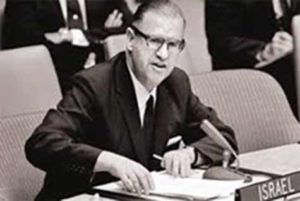November 23, 1956 Egypt – Israel’s Ambassador Abba Eban
Israel’s Ambassador Abba Eban told the Security Council that the Sinai Peninsula, which had been completely unarmed, except for a small Egyptian garrison at El Arish, had been built up into a huge Egyptian base. On it Nasser had spent $42 million for military installations including two air fields capable of accommodating jet planes.
When the Israelis captured Sinai this is what they found, according to Ambassador Eban:
“Large advance ammunition depots were found by us at El Arish and at El Midan and Abu Awgeila. Other supply depots were in the process of construction at Jebel Lebini. Fuel storage tanks were set up at El Arish, Abu Awgeila and Bir Rodsalim. Supplies of arms and spare-parts depots were set up in El Arish, in Abu Awgeila and in Nahal Rafa. All these depots were but a short distance from the Israel frontier. The quantities of arms, equipment and ammunition stored up in these installations were sufficient to sustain an all-out attack on Israel by all the existing units of the Egyptian armed forces. The fact that these depots included large quantities of ammunition for the guns of heavy tanks of the Centurion and Stalin types proves that they were intended to serve an attacking force and not a defense army. Road developments which had been carried out in the area were clearly designed solely for military purposes and not for the benefit of the sparse Bedouin population. Thus, a road running parallel to the existing railroad tracks was constructed between Kantara and El Arish. The Suez-Quseima road was being covered with asphalt. Wide roads were constructed between El Arish, Jebel Lebini, Bir Hassaneh, Abu Awgeila, Quseima and others. Telephone wiring was set up along the roads. The two airfields to which I have referred were constantly being improved and the runways repeatedly lengthened to accommodate new and more devastating types of aircraft. Recently, these airfields were specially adapted for the use of jet planes.
“Egyptian documents captured in the campaign illustrate the transition from the defensive policy prevailing until 1953 to an offensive military objective. These documents include detailed planning for and reports of reconnaissance patrols in southern Israel and full intelligence reports on Israel’s farming settlements, detailing their defense arrangements and the approaches to them. In Egyptian military education pamphlets found in the area, stress is laid on the aggressive spirit necessary to prepare for the day of revenge.
“My Government has submitted to the Security Council the effective operation orders in which Egyptian officers in Sinai and the Gaza Strip were bidden by their superiors to regard their objective as being the destruction of the Sate of Israel by the most brutal and savage means of fighting. The deployment of Egyptian forces in the Sinai Peninsula and in the Gaza Strip was progressively increased, and at the time of the Suez crisis it had risen to three infantry divisions and two armored brigades. By then, these forces, relying on supplies in advanced depots, were in a position to launch an attack on Israel, if necessary, within less than twenty-four hours. On Sharm el-Sheikh on the southernmost tip of the Sinai Peninsula, a military fortified base was constructed sufficient to accommodate an infantry battalion. An airfield, jetties and shore batteries were also set up. All this, of course, was for the sole purpose of effectively blocking the Gulf of Aqaba, the Straits of Tiran, and to complete the maritime blockade a base for torpedo boats was erected on the Red Sea south of the Suez.
“This, then, is the scene which was revealed to our eyes during the action in the Sinai Peninsula. Here was a wilderness bristling with death, pushing up against Israel’s populated centers, and across the other side of the frontier, in Israel’s territory, could be seen the targets for this massive rearmament – isolated farm settlements populated by young pioneers with pathetically primitive watchtowers and small arms defenses. Therefore, everything that has come into our hands and into our knowledge since I last addressed the General Assembly has fortified our conviction that the disaster which we prevented was far greater and more drastic than any of the hazards or perils which our limited military action incurred.”




